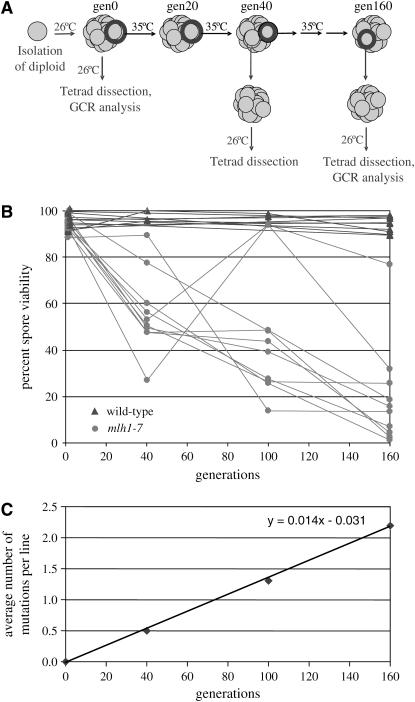Figure 1.—
Mutation accumulation in wild-type and mlh1-7 strains. (A) Schematic of the mutation accumulation procedure. Wild-type (EAY102 MATa his3 cyhs ade2 ura3 trp1/EAY104 MATα leu2 cyhr ura3 trp1) and mlh1-7 (EAY1491 MATa his3 cyhs ade2 ura3 trp1 mlh1-7∷KanMX4/EAY1492 MATα leu2 cyhr ura3 trp1 mlh1-7∷KanMX4) S288c diploid strains were isolated by mating the indicated haploid strains at the permissive temperature (26°) and then by selecting for diploids on complete media lacking leucine and histidine. The resulting single colonies were frozen in glycerol stocks; these isolates were designated as generation 0. Portions of each single colony were also struck out on YPD plates to obtain single colonies at 26° and 35°, and stable diploid lines were propagated at 26° or 35° by serial transfer of randomly chosen colonies on YPD plates. Colonies were frozen every transfer (∼20 generations). To determine spore viability at generation 0, cells were patched from frozen stocks onto YPD plates, grown overnight at 26°, and then plated on sporulation media. To determine spore viability and analyze DNA at later generations, cells from the frozen stocks were first struck to single colonies at the permissive temperature to reduce mutation accumulation and obtain a uniform population of cells. These single colonies were frozen, and samples were taken from frozen stocks to determine spore viability and isolate genomic DNA for pulsed-field electrophoresis and CGH. All tetrads were dissected on minimal complete plates. Colonies visible to the naked eye after 4 days at 26° were scored as viable. (B) Spore viability of 10 mlh1-7 lines (solid circles) was assessed after 0, 40, 100, and 160 generations at 35°. Spore viability of 10 wild-type lines (solid triangles) was assessed after 0 and 160 generations at 35°; that of three of the lines was also assessed after 40 and 100 generations. A total of 40–100 tetrads was dissected for each wild-type and mlh1-7 line at the indicated generation. (C) Relationship between the average number of recessive lethal mutations per mlh1-7 isolate and generation. See text for details.

